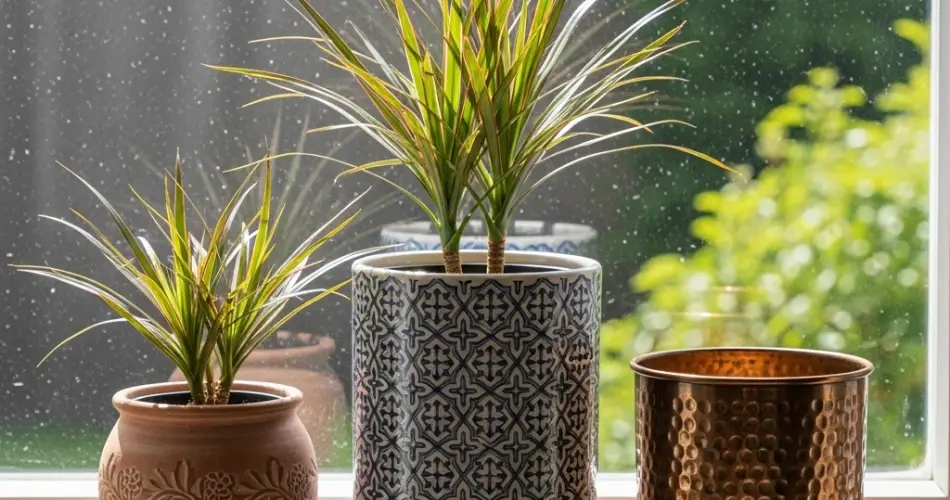Dracaena is a versatile genus of ornamental plants that includes a wide array of striking indoor varieties like Dracaena marginata, Dracaena fragrans (corn plant), Dracaena reflexa (song of India), and Dracaena compacta. Known for their sculptural form, air-purifying ability, and low-maintenance care, these plants are ideal for containers and thrive indoors year-round.
If you’re looking to create a beautiful indoor garden using several types of Dracaena, container gardening is a practical and visually appealing approach. Here’s how to successfully grow and maintain multiple Dracaena varieties in pots, even if space is limited.
Choosing Your Dracaena Varieties
Start by selecting a mix of Dracaena types with differing colors and shapes to add interest to your container garden. Some great combinations include:
-
Dracaena marginata: Slender, upright with thin, spiky leaves edged in red.
-
Dracaena fragrans: Broad green leaves that may feature yellow or white stripes.
-
Dracaena reflexa: Also called “song of India,” with curved leaves and yellow-green variegation.
-
Dracaena compacta: A slow-growing, deep green variety with dense foliage, perfect for small pots.
Combining tall and compact varieties creates vertical interest and can help fill space without cluttering your room.
Container Selection
Each plant should be potted individually unless you’re creating a mixed arrangement in a single, large planter. If you choose to group multiple Dracaenas in one pot, make sure they have similar light and watering needs.
Use pots with drainage holes to prevent water from accumulating at the bottom and causing root rot. Terracotta or ceramic pots allow better airflow and moisture control, while plastic pots retain moisture longer—choose based on your watering habits.
The Ideal Potting Mix
Dracaena prefers loose, well-draining soil. A general-purpose indoor potting mix works fine, but you can improve drainage by adding:
-
Perlite or pumice (for aeration)
-
Coco coir or peat moss (for moisture retention without waterlogging)
-
A small amount of sand (optional, for extra drainage)
Avoid using heavy garden soil or any mix that retains excess water.
Light Conditions
Most Dracaena varieties prefer bright, indirect light, though they can tolerate lower-light environments. Too much direct sunlight may scorch the leaves, while too little light can cause leggy growth and faded colors.
For vibrant foliage:
-
Place near east- or west-facing windows.
-
Use sheer curtains to diffuse intense sunlight.
-
Rotate pots occasionally to ensure even light exposure.
If you’re growing multiple types in different rooms, adjust positioning based on the needs of each variety.
Watering Routine
Dracaenas are relatively drought-tolerant and prefer to dry out slightly between waterings. Overwatering is one of the most common problems with these plants.
Here’s a basic watering guide:
-
Water when the top 2–3 cm (1 inch) of soil is dry.
-
In winter, reduce watering frequency.
-
Use room-temperature water.
Note: Dracaena is sensitive to fluoride and salts in tap water, which can cause leaf tip burn. Use filtered or distilled water when possible, or let tap water sit out overnight before using.
Fertilizing for Growth
Feed Dracaena every 4–6 weeks during spring and summer with a diluted balanced liquid fertilizer. Avoid overfeeding, which can lead to salt buildup in the soil and damage the plant.
In fall and winter, hold off on fertilizing, as plant growth naturally slows.
Pruning and Maintenance
To keep your Dracaena plants looking tidy:
-
Trim brown leaf tips with clean scissors.
-
Remove dead or yellowing leaves near the base.
-
Cut back leggy stems to encourage bushier growth.
Pruned sections can be propagated in water or moist soil if you want to expand your collection or replace older, woody plants.
Repotting Tips
Dracaena grows slowly, so repotting every 2–3 years is usually sufficient. When roots begin to circle the pot or grow out the drainage holes, it’s time to move up a pot size.
Steps to repot:
-
Water the plant a day before to ease root removal.
-
Gently lift it out, trim dead roots, and place in a fresh mix.
-
Firm the soil gently around the root ball and water lightly.
Pests and Problems
Common issues to watch for include:
-
Spider mites and mealybugs: Remove with insecticidal soap or neem oil.
-
Brown tips: Usually due to dry air, fluoride, or inconsistent watering.
-
Yellowing leaves: Often caused by overwatering or poor drainage.
Wipe the leaves occasionally to remove dust and keep the plant breathing freely.
Display Ideas for Multiple Dracaena
You can arrange Dracaena plants in groups by height or leaf color for maximum visual effect. Tall types like marginata make excellent floor plants, while compact varieties can sit on shelves, desks, or plant stands.
Use matching pots for a minimalist look or mix container styles for a more eclectic indoor jungle vibe.
Final Thoughts
Dracaena’s elegant structure, wide variety, and forgiving nature make it perfect for pot culture. By combining different species in suitable containers and offering proper care, you can create a beautiful, low-maintenance indoor plant collection that thrives in a variety of settings. Whether you’re after clean modern décor or a lush tropical feel, Dracaena delivers with ease.



